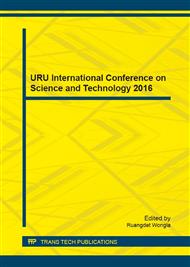p.3
p.9
p.15
p.22
p.26
p.31
p.37
p.42
Determination of Lead Desorption from G. fisheri Seaweed Using Edible Eluents by Voltammetry at the Hanging Mercury Drop Electrode
Abstract:
A simple, rapid, selective and sensitivity approach for the determination of Pb(II) in G. fisheri seaweed is described. The method is based on differential pulse anodic stripping voltammetry (DPASV) at hanging mercury drop electrode (HMDE) vs. Ag/AgCl in 0.2 M ammonium acetate (NH4OAc) pH 7.5. The operating analytical conditions; deposition potential (Edep) of -0.4 V, peak potential of -0.78 V, and mercury dropped size of 3 were performed. To see the sensitivity of Pb(II) measurement, the influences of deposition time and stirring speed were investigated. From the findings, the optimal parameters; deposition time of 90 s, and stirring speed of 2000 rpm were obtained. In these conditions, the limit of detection (3σ) of 0.60 µgL-1 and the linear range extended to 12.50 µgL-1 (r2=0.9999) were obtained. The relative standard deviation (RSD) of triplicate measurements using 1.8 µgL-1 of Pb(II) was 1.22%. The method was then applied to measure Pb(II) in real samples. In this study, the desorption efficiency of edible eluents by batch method was determined. The method is based on Pb(II) desorption using different types of edible eluents; acetic acid (HOAc), citric acid (CTA), sodium chloride (NaCl), sodium bicarbonate (NaHCO3), ethylenediaminetetraacetic acid (EDTA), and chitosan (CTS). Batch desorption of Pb(II) from seaweed soaked in individual eluent was performed by shaking at 100 rpm for 2 h at ambient temperature. Results show that the most effective eluent in desorbing the contaminated Pb(II) from G. fisheri with up to 82% of desorption efficiency for bound Pb(II) was EDTA solution.
Info:
Periodical:
Pages:
3-8
Citation:
Online since:
October 2016
Authors:
Keywords:
Permissions:
Share:
Citation:


